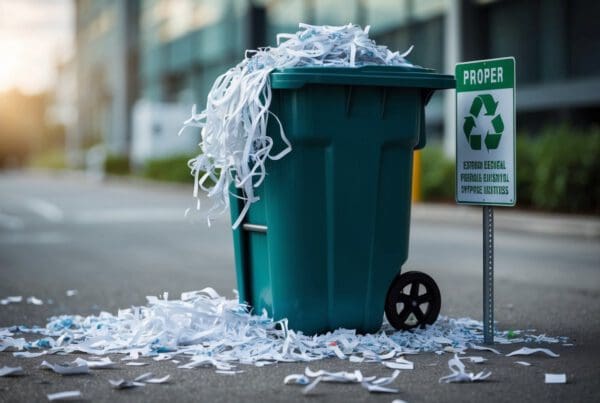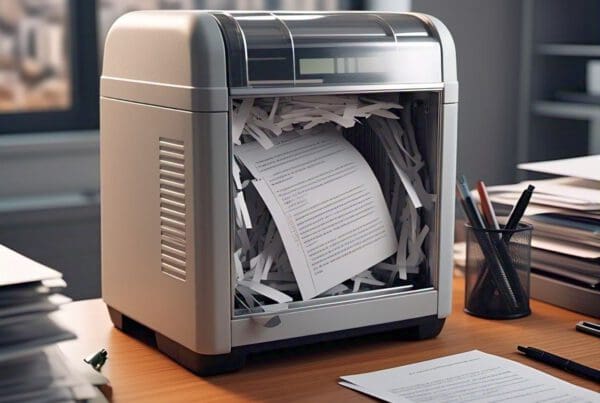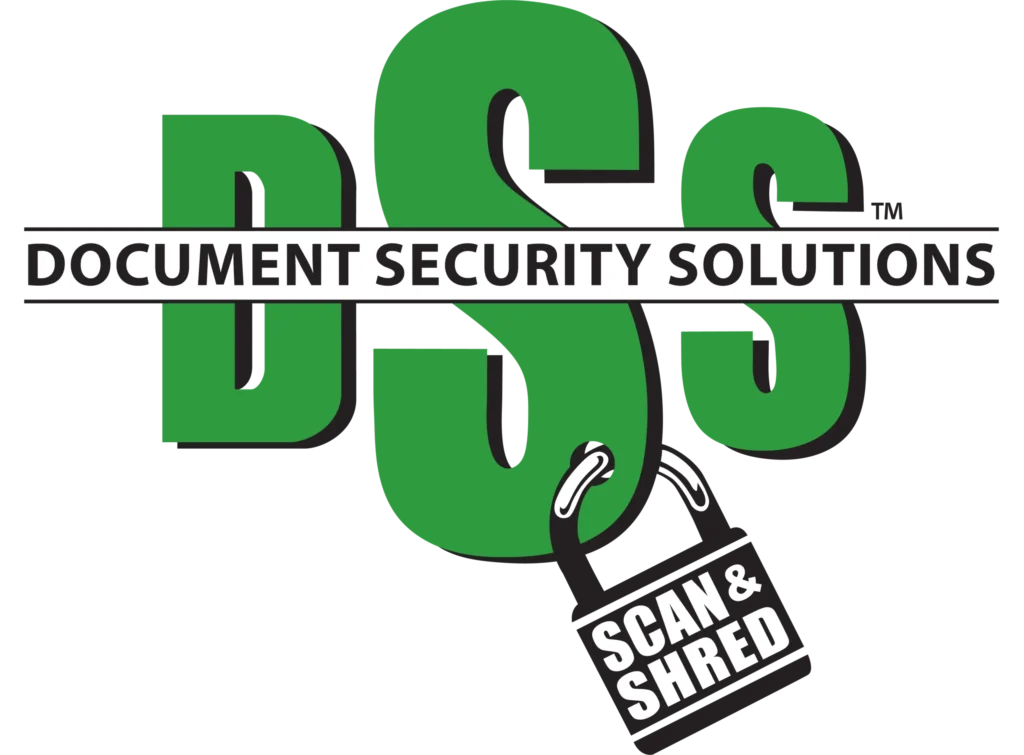Understanding Document Shredding

Document shredding is crucial to protect sensitive information. It helps safeguard against identity theft and data breaches by ensuring documents are destroyed properly. We must recognize what counts as sensitive and the risks that come with poor shredding practices.
What Constitutes Sensitive Documents?
Sensitive documents include any paperwork containing personal data, financial records, or proprietary business information.
Examples include:
- Bank statements
- Tax documents
- Insurance records
These documents often contain personal details like Social Security numbers or account information, which can lead to unauthorized access if not disposed of securely. Hence, identifying these documents is the first step toward proper document management and security.
Risks of Inadequate Document Destruction
Failing to properly destroy documents can result in serious risks, such as identity theft and data breaches. When sensitive papers are thrown away without shredding, they might be retrieved and used maliciously. This can lead to financial loss, reputational damage, and legal consequences for us.
Protecting our data with appropriate shredding practices is essential. By ensuring that sensitive documents are unreadable, we help protect ourselves against potential threats. Investing in a good shredder or using a professional shredding service can significantly reduce these risks.
The Importance of Privacy and Data Protection
Protecting privacy and ensuring data security is vital in today’s world. Shredding sensitive documents helps maintain confidentiality and prevents unauthorized access. Data breaches can expose personal and financial information, leading to serious consequences.
By emphasizing document security, we play a crucial role in safeguarding our personal and business information. Being proactive about privacy not only protects individuals but also builds trust in professional environments. Document shredding is a simple, yet effective, practice to ensure our private information remains secure.
Methods of Shredding and Document Destruction
Selecting the right method for destroying sensitive documents is crucial. We explore the different shredders and destruction methods to keep your information safe.
Strip-Cut Shredders Versus Cross-Cut and Micro-Cut Shredders
Strip-Cut Shredders are the simplest type. They slice paper into long, thin strips. While they are cost-effective, strip-cut shredders might not provide the best security for highly private documents. Let’s be honest, leaving long strips can still be pieced together.
For greater security, cross-cut shredders are a better option. By cutting documents into small, square pieces, they make reconstruction much harder. At the top, we have micro-cut shredders, which reduce paper to confetti-like particles, offering the highest level of security. These are ideal for extremely sensitive information where privacy is key.
Pulping, Burning, and Other Destruction Practices
For those who want to go beyond shredding, methods like pulping and burning offer different benefits. Pulping involves mixing paper with water and chemicals, turning it into a mushy pulp. This ensures complete destruction but can be messy and requires special handling.
Burning documents is another effective way to destroy paper entirely. It’s best for items that must be obliterated completely. Incineration leaves no traces but requires a safe environment and compliance with local regulations.
Other options include chemical destruction and dissolving, which effectively eliminate paper but may involve extra costs and precautions. Understanding the risks and benefits of each method can help us choose the best way to keep our information secure.
Deciding Between On-Site and Off-Site Shredding
When deciding between on-site shredding and using a shredding service, consider practicality and security. With on-site shredding, documents are destroyed right at our location. This offers immediate security since we can witness the process. However, it requires having a shredder on hand and managing it ourselves.
Off-site shredding uses a service where the documents are collected and destroyed elsewhere. It is convenient, often handling larger volumes of paper at a lower cost. The trade-off is trusting third-party operators with secure transportation and handling of our documents.
Both methods, when done correctly, ensure the successful destruction of documents. The choice depends on our specific needs for security and convenience.
Adhering to Legal and Regulatory Standards

Keeping up with laws and rules when shredding sensitive documents is key. We focus on knowing the rules, proof of destruction, and keeping documents only as long as needed.
Understanding Compliance and Regulations
We must follow various regulations to protect privacy. These laws can differ based on industry and location. HIPAA in healthcare requires us to handle patient info carefully. In finance, GLBA ensures client details remain confidential.
It’s crucial we stay updated with any changes or new rules. Monitoring compliance not only protects our organization from fines but also builds trust with clients. We should implement regular training sessions and updates for our team to ensure everyone is aware of current practices and expectations.
Certificate of Destruction and Audits
A Certificate of Destruction offers proof that documents have been properly destroyed. This certificate is crucial for legal and compliance reasons. It includes details like the date, time, and method of shredding.
Audits are another aspect we must be ready for. Regular audits can help us ensure our processes meet all necessary standards. Having a clear, documented process with audits allows us to identify potential lapses and address them promptly, safeguarding sensitive information.
Developing Document Retention Policies
A solid document retention policy helps determine how long we keep documents. Keeping records too long can be risky, while disposing of them too soon might lead to non-compliance.
Our policy should specify retention times for each document type based on legal and business needs. Review and update these policies regularly to align with changing regulations. This practice ensures we protect personal information and maintain compliance with key privacy regulations and guidelines.
Best Practices for Document Shredding
When shredding documents, it’s important that we follow secure procedures, choose the right shredding service, and integrate shredding into daily operations efficiently.
Secure Procedures to Prevent Data Breaches
We must ensure that documents are shredded securely to prevent data breaches. Use locked bins for collecting sensitive information before it’s shredded. This keeps unauthorized individuals from accessing documents.
It’s vital we implement a strict chain of custody. This means tracking the document from the time it is placed in the shredding bin until it is finally destroyed. This process helps maintain accountability.
For companies with strict security policies, mobile shredding services provide on-site destruction of documents. This allows us to witness the shredding process, ensuring maximum security.
Choosing Professional Shredding Services
Selecting the right shredding service is essential for safe and efficient disposal. We should look for services that are certified by recognized bodies, ensuring they uphold high security standards.
Evaluate their chain of custody protocols to be sure they track each document securely from collection to destruction. This is key in maintaining trust that our sensitive data is handled responsibly.
Proximity and convenience matter too. Mobile shredding options may be beneficial, allowing us to schedule shredding at our location and witness the entire process for assurance.
Integrating Shredding into Business Productivity
To boost productivity, it’s crucial that we integrate shredding seamlessly into our regular workflow. Creating a document disposal schedule can help us consistently manage shredding without disrupting day-to-day tasks.
Training our team on shredding procedures increases efficiency. Education on what needs shredding and when can cut down on unnecessary work, focusing only on what’s crucial.
Automating the shredding process through professional services can free up employee time. As we rely on professional document destruction services, it ensures that shredding is completed regularly, maintaining productivity.
Environmental Considerations and Recycling
As we focus on disposing of sensitive documents, it is crucial to consider eco-friendly practices and the recycling of shredded materials to support environmental sustainability.
Implementing Eco-Friendly Practices
When shredding sensitive documents, we should adopt eco-friendly methods. First, we can use energy-efficient shredders, which consume less electricity. These machines help minimize our carbon footprint. Some shredders have a sleep mode to save power when not in use.
Next, we should select shredders with low noise levels, reducing noise pollution. It is also helpful to use shredders that require minimal maintenance to prevent waste of resources. We can further boost sustainability by opting for shredders made from recycled materials.
Finally, using shared shredding services can reduce costs and environmental impact. This cooperative approach prevents the unnecessary purchase and use of multiple machines.
Recycling Shredded Materials
Recycling shredded paper is an important step in environmental sustainability. After shredding, we should bag the paper separately to keep it clean and free from contaminants. This ensures efficient recycling processes and better-quality recycled paper products.
Many local recycling centers accept shredded paper. We can reach out to them to inquire about specific guidelines for recycling shredded materials. This allows us to contribute effectively to the recycling process.
In some cases, companies provide secure recycling services. These services ensure that sensitive documents are protected during transit and properly recycled. Utilizing such programs can be a secure and responsible choice for document disposal.





